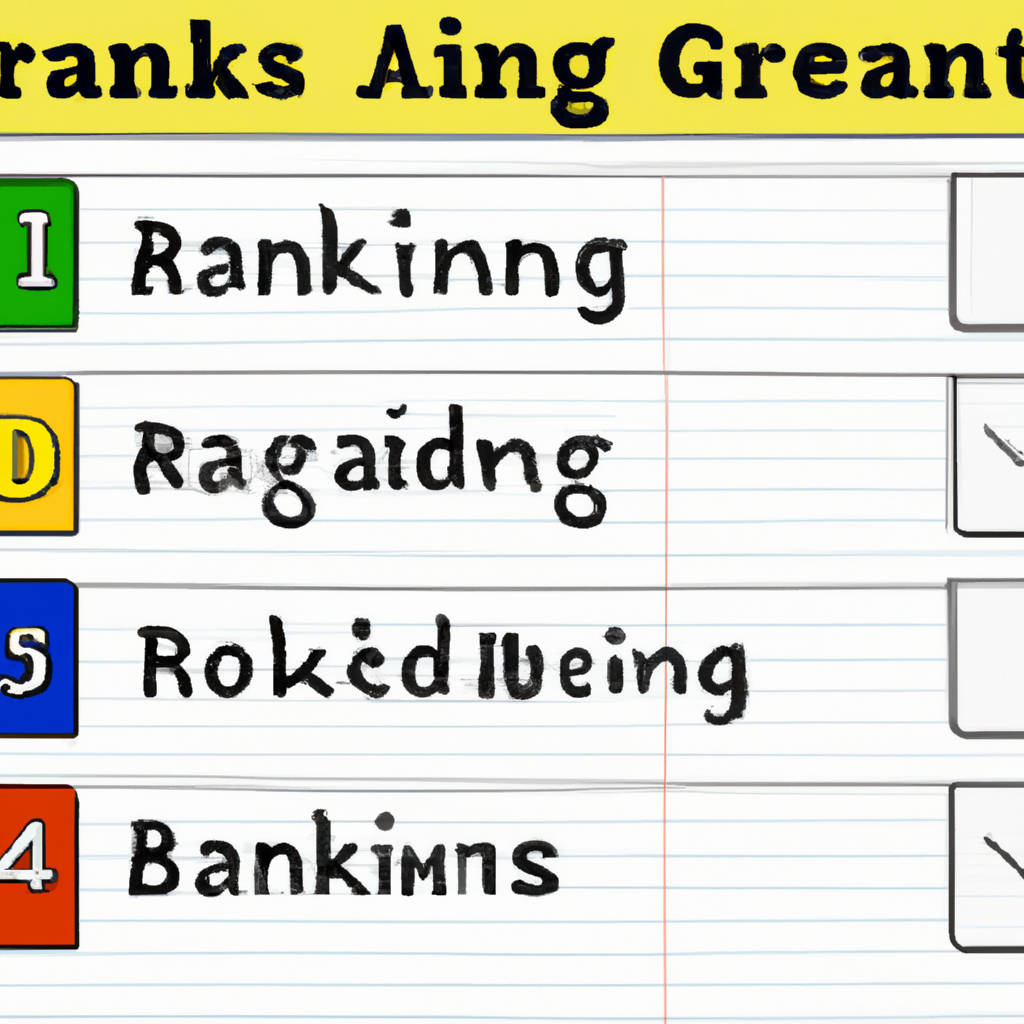Introducing ranking questions in Google Forms is an effective way to obtain prioritized feedback from respondents. This type of question allows participants to rank items in a particular order, based on their preferences or opinions. To add a ranking question in Google Forms, start by creating a new form or editing an existing one. Then, click on the ‘+’ button to add a new question. In the dropdown menu for ‘Question Type’, select ‘Linear Scale’ or ‘Multiple Choice Grid’ as these are the closest options for ranking questions. If you choose ‘Linear Scale’, you can define a scale (for example from 1 to 5) for respondents to rate items.
If you choose ‘Multiple Choice Grid’, you can list down items in rows and ranking scale in columns, thus allowing respondents to rank each item. Remember to provide clear instructions on how to rank the items to avoid any confusion. With these steps, you’ll be able to successfully add ranking questions in Google Forms, making your survey or feedback form more interactive and comprehensive.

Create a New Google Form
Creating a new Google Form is a straightforward process that is user-friendly and efficient. To begin, one needs to navigate to the Google Forms website. Once there, you can start a new form from scratch or choose from a variety of pre-made templates. If you opt to start from scratch, the platform allows you to customize every aspect of the form, including the question types, theme, color scheme, and font. You can add as many questions as you need, and the form will automatically save your progress. One of Google Forms’ most beneficial attributes is its seamless integration with other Google services.
For instance, you can easily import contacts from Google Sheets for distribution or save responses directly to a spreadsheet for analysis. Sharing the form is also simple, whether it’s through a direct link, via email, or embedded on a website. Google Forms also includes features that enhance accessibility and ease of use, such as the ability to include images, videos, and sections, which can help guide the respondent through the form. One critical aspect to remember when creating a Google Form is to ensure privacy and data protection measures are in place.
Google Forms are secure, but it is crucial to restrict access and sharing permissions to maintain the confidentiality of responses. Lastly, Google forms also provide the facility to preview the form before it is sent out to ensure that everything is in order. By following these simple steps, you can create a Google Form that is tailored to your specific needs and give your audience an easy-to-use tool to provide the information you need.
Add a New Question
Adding a new question to any discussion, survey, or poll can significantly shape the direction of the conversation, thereby influencing the overall outcome. This process is both an art and a science, necessitating a keen understanding of the subject matter and the target audience. Prior to adding a new question, it’s essential to determine if it aligns with the topic at hand and contributes to a broader understanding of the issue. The question should be clear, concise, and unbiased to ensure that it doesn’t lead respondents towards a particular response.
Use of open-ended questions can encourage more in-depth answers, revealing insights that may not emerge from multiple-choice queries. However, the question should not be too complex or confusing as it can deter the respondent from providing a truthful response. The phrasing and terminology must also be considered. The words should be neutral and straightforward, avoiding any industry jargon or complex terms that can be misunderstood. It’s also crucial to consider the placement of the new question.
Positioning it at the beginning could set the tone for the rest of the conversation, while placing it towards the end might provide respondents with more context. Lastly, we must consider the potential responses and how they will be analyzed. If a question does not yield useful data or contribute to the overall objective, it might be best to reconsider its inclusion. In conclusion, adding a new question is a strategic step that requires careful consideration of various factors, including the clarity of the question, the language used, the placement, and the potential responses.

Choose the Question Type
Choosing the question type is a crucial aspect when formulating a survey, conducting research, or simply communicating effectively. This decision impacts the kind of information gathered and the depth of understanding achieved. There are several types of questions that can be employed, each with their unique benefits and drawbacks. The most common are open-ended, multiple-choice, dichotomous, scale, and ranking questions. Open-ended questions provide a platform for respondents to express their thoughts and feelings in detail, offering rich qualitative data.
However, they require more time and effort to analyze. Multiple-choice questions, on the other hand, provide quantitative data that is easy to analyze and compare, but they limit respondents’ answers within predetermined choices. Dichotomous questions, often yes/no questions, are straightforward but offer little room for nuance. Scale questions, such as Likert scale questions, measure the intensity of feelings towards a statement or product. Finally, ranking questions ask respondents to compare different items to each other. The type of question chosen depends largely on the objective of the inquiry.
If the goal is to understand the depth of a respondent’s feelings or perspectives, open-ended questions may be more effective. For statistical analysis, multiple-choice, dichotomous, scale, or ranking questions may be more suitable. It’s essential to remember that the question type chosen will significantly influence the responses received, and consequently, the value of the data collected. Therefore, careful consideration should be given when selecting the question type to ensure it aligns with the desired outcomes of the inquiry.
Configure the Multiple Choice Question
Configuring a multiple choice question is an integral aspect of creating comprehensive and effective quizzes, tests, or surveys. This form of question provides a range of potential answers for respondents to choose from, thereby facilitating the collection of data or performance evaluation. In the process of setting up a multiple-choice question, it’s crucial to define the question clearly and provide a set of plausible answers. One answer will be the correct response, while the others, often termed as ‘distractors,’ are incorrect but might seem feasible. The key aim of this design is to challenge the respondent’s understanding of the topic at hand.
When you configure a multiple-choice question, ensure that the question is specific, clear, and directly relatable to the subject matter. Including ambiguous or excessively complex questions can confuse respondents and detract from the purpose of the exercise. In terms of the answer choices, it’s generally advised to offer between three to five potential responses. Too few choices make the question too easy, while too many can be overwhelming.
The distractors should also be thoughtfully designed. They should be plausible enough to be selected by someone who does not fully understand the topic. However, they shouldn’t be so difficult that they confuse those who have a good understanding of the material. Carefully thought-out distractors can help gauge the depth of a respondent’s knowledge and comprehension.
Lastly, avoid using negative wording or double negatives in your questions, as they can confuse learners. Also, ensure all your options are mutually exclusive and that there’s only one clearly correct answer. Regularly reviewing and updating your multiple-choice questions is also essential to maintain their relevance and effectiveness.
In conclusion, configuring multiple-choice questions requires careful consideration, thoughtful design, and a clear understanding of the subject matter. When done correctly, these questions can effectively measure a respondent’s comprehension and knowledge of a particular topic.

Enable Ranking
Enable ranking refers to a system that allows the arrangement and classification of items or individuals based on a certain criteria or standard. It is a useful tool in various fields such as education, business, sports, and even in online platforms. In education, it is often used to rank students according to their academic performance. In business, products or services may be ranked based on their sales or customer reviews. In sports, athletes or teams are ranked based on their performances or scores. Online platforms, on the other hand, use ranking algorithms to personalize user experience.
Enable ranking is not just about creating a hierarchy. It is about understanding the strengths and areas for improvement of each item or individual included in the ranking. It is about identifying the best practices and learning from those who are at the top of the ranking. In a way, it encourages competition and motivates individuals or teams to strive for excellence.
However, it is crucial that the process of ranking is fair, transparent, and objective. The criteria or standards used in ranking must be clear, relevant, and applicable to all. It is also important to consider the dynamics and complexities of each field when creating a ranking system. For instance, in education, a ranking system that only focuses on academic performance may overlook other important aspects such as creativity, leadership, and social skills. In business, a ranking system that only considers sales may ignore the quality and sustainability of the products or services.
To sum up, enable ranking is a powerful tool that can drive improvement and excellence. But it should be used wisely and responsibly, taking into consideration the unique circumstances and factors in each field.
Set Up the Ranking Grid
Setting up a ranking grid is an essential process used in various fields to sort and categorize items or individuals based on certain criteria. The objective of a ranking grid is to establish a structured hierarchy that helps in making informed decisions. The process begins by identifying the elements that need ranking. These could be products, services, employees, applicants, or any other set of items that require comparison. Following this, the criteria for ranking are determined. These are the standards or benchmarks that the items will be judged upon. They should be relevant, clear, and unbiased to ensure a fair evaluation.
The next step is to assign values or scores to each item based on these criteria. This could involve a simple numbering system or a more detailed scoring matrix, depending on the complexity of the ranking process. It’s crucial at this stage to maintain consistency in scoring to avoid any disparities in the final ranking. After the scores are assigned, they are then entered into the grid, forming a table where each row represents an item and each column represents a criterion.
The final step is to calculate the total scores for each item and arrange them in descending order to form the ranking. The item with the highest total score is ranked first, followed by the item with the second-highest score, and so on, creating a clear hierarchy. It’s important to note that the ranking grid is a dynamic tool that can be adjusted and updated as the criteria or items change over time. By following these steps, one can efficiently set up a ranking grid, providing a structured framework that greatly aids in decision-making processes.
In essence, a well-constructed ranking grid can greatly simplify the task of comparing and prioritizing items, leading to more effective and streamlined operations. Whether it’s for product development, human resources, marketing, or any other field, setting up a ranking grid can significantly enhance the efficiency and accuracy of assessment and decision-making processes.
